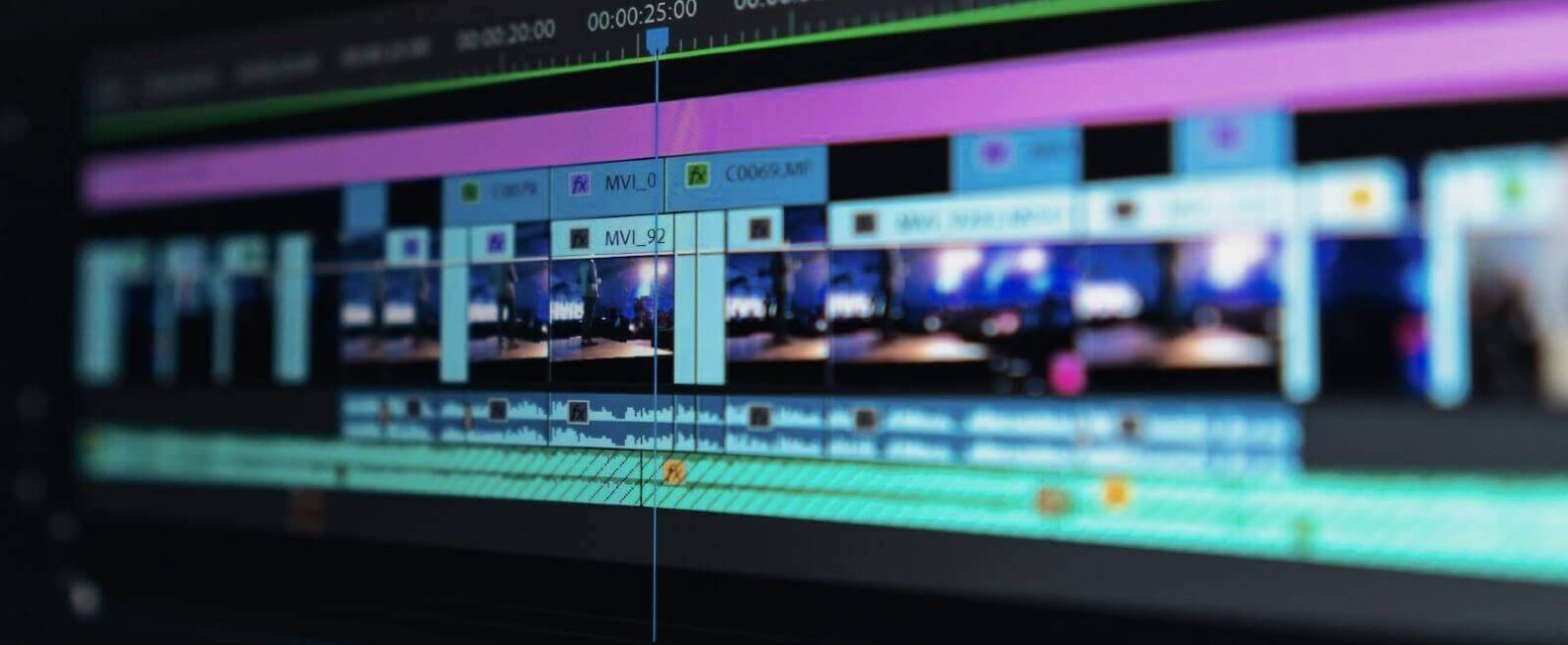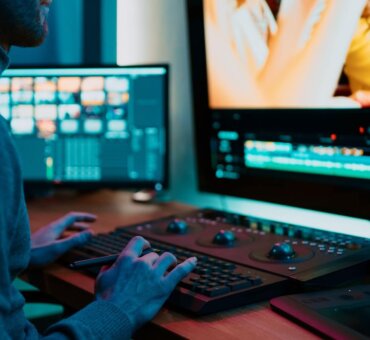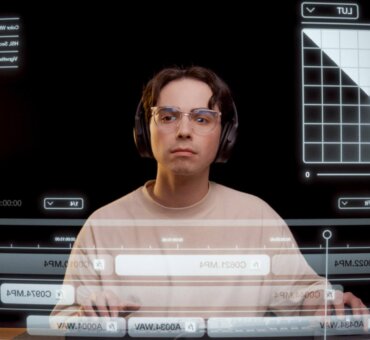There are a variety of editing programs that are widely used within the film industry, and the choice of software will depend upon what you are editing, your choice of workflow, and if there are extra demands like 3D, VFX, or animation.
Importance of Editing Software
Editors are central to the look of a final movie because some of the most important creative decisions are made in the edit suite. We go into this more deeply in our article about the professional skills for every editor to master, and your video editing software is the place a movie is made. The choice of software will largely depend on the demands of your projects, whether they are web series, short films for the festival circuit, feature films, or projects that require collaboration with other editors.
Mac or PC?
Both Macs and PCs are used in Hollywood post-production studios, and there are compelling arguments for both sides. Apple is clearly a plus when running its own native software like Final Cut Pro and Motion, while both Macs and PCs work well for other NLE software like Adobe Premiere Pro. Meanwhile, a PC might come in at a lower price tag and have cheaper options for hardware upgrades and customizations.
NLE Editors
Back in the day, there was a linear kind of editing, where you had a single timeline that consisted of either a film reel or video. Film editors now have the option to place multiple tracks on a sequence, overlay and overlap footage, add titles and special effects, and place endless effects on top of clips. This “offline edit” or “non-linear edit” is the reason they are called NLEs or non-linear editors.
We will talk about editing programs that are used in the film industry, and explain why they are used.
Adobe Premiere Pro
Adobe Premiere Pro has been the film industry standard for many years, used by independent filmmakers and Hollywood productions. Movies include Deadpool, Gone Girl, and Hail, Caesar! In many ways it is the perfect NLE, incorporating an extensive library of special effects, an audio mixer, plugin integration, and more.
There is a 30-day free trial for Adobe Premiere Pro, and after that, it’s $19.97/month. Another upside to Premiere Pro is that it is part of the Creative Cloud family of apps that also includes After Effects, Adobe Express, Audition, and Animate. These are seamlessly integrated for an easy and professional workflow, and the monthly cost for all of them is $51.98 per month (as of 2023). Additionally, you can upgrade to include other Adobe apps, whether it is for VR and 3D, stock footage, or Photoshop.
Final Cut Pro X
Final Cut Pro X is the NLE-of-choice for many Mac users, despite the fact that Adobe Premiere Pro can also run on Apple. Final Cut is often the next step for people who have outgrown iMovie, although many people believe that FCPX’s capability falls short of Adobe Premiere Pro. Nonetheless, an important feature is Final Cut’s faster rendering speed, which has become even faster since the release of the new M1 chips that are made exclusively for Apple machines.
Films edited with Final Cut Pro X have included The Social Network, The Girl with the Dragon Tattoo, and X-Men Origins: Wolverine. In some ways, it is easier to learn than Adobe, and a big benefit is that the cost of Final Cut Pro X is a one-off payment of $299 rather than ongoing fees to use Premiere Pro. Apple also gives you a full three-month trial as opposed to Adobe’s 30 days.
Finally, a major plus is that you have easy access to the full Apple ecosystem and ongoing support from Apple. You can try Final Cut Pro X for free for 90 days.
DaVinci Resolve
DaVinci Resolve announces itself as “Hollywood’s #1 Post Solution,” and its color-correcting capabilities have meant that it’s used across a vast array of movies. It allows for multiple editors to collaborate in real-time on the same project timeline, and its Apple integration allows for up to 30x faster playback on Apple models with the M1 chip.
DaVinci has the reputation as the most advanced color corrector, which has meant that it is often used in addition to Adobe Premiere Pro and Final Cut Pro X. Projects are exported from other NLE programs, graded in Davinci, and then reimported into the respective editors. However, entire projects can be easily edited without ever having to leave DaVinci, since it also integrates their Fusion page for cinematic visual effects and motion graphics, Fairlight pro tools for audio post-production, Neural Engine which uses machine learning for AI effects like facial recognition and Resolve FX for cutting-edge VFX.
Films edited on DaVinci Resolve include Alien: Covenant, Avatar, Deadpool 2, Jason Bourne, Kingsman: The Golden Circle, La La Land, and Star Wars: The Last Jedi.
What’s even more impressive is that DaVinci Resolve is entirely free to download and use. The DaVinci Resolve Studio is $295, and it includes the DaVinci Neural Engine along with many additional VFX options.
Vegas Pro
Vegas Pro, formerly Sony Vegas, is a professional-level NLE and specific to Windows machines. Its nested timeline feature allows you to group scenes away from your main timeline, allowing for easy collaboration with other editors and VFX specialists.
There is a 30-day free trial for Vegas Pro, and it then costs $13.29-$19.99 per month depending on seasonal promotions. Vegas Post costs $13.49-19.99 per month.
Avid Media Composer
Avid Media Composer has been an industry standard for many years, and a first choice for feature films, documentaries, and television. Whilst it isn’t always used as a finishing tool like Final Cut Pro X, it is robust and very popular in Hollywood and beyond.
Films edited with Avid Media Composer include Terminator 2, Life is Beautiful, and Million Dollar Baby.
Avid Media Composer costs $191-239 for an annual license or $1,699 for a perpetual license. Monthly plans start at $23.99 and there is a free trial available.
3D & Animation
Next to the popular NLEs we have another rich family of apps and programs that help create and modify three-dimensional objects and models as well as create animations and VFX. These programs are often used for CGI in films, 3D animation, game development, architecture, and beyond.
Cinema 4D
Maxon’s Cinema 4D is designed for 3D computer animation, modeling, simulation, and rendering software, and includes Pyro for fire, explosions, and smoke. It’s great for design, games, motion graphics, and visualizations.
Films that used Cinema 4D include The Girl with the Dragon Tattoo and Spider-Man 3. Cinema 4D has a 14-day free trial period.
Autodesk 3ds Max
3ds Max is a 3d modeling software that allows you to create worlds using its rendering and animation capabilities. There are robust modeling tools that help you create environments, landscapes, designs, and props, along with professional-grade renders.
Films that used Autodesk 3ds Max include Mad Max: Fury Road and Lost in Space. You can download 3ds Max and try it for free here.
Adobe After Effects
Adobe After Effects is a go-to program for creating visual effects that match your imagination. Whether it is creating titles, 2D and 3D animations, or visually manipulating other imported media, After Effects is the ultimate app for motion graphics. It has been used on many films, including JJ Abrams’ Star Trek Into Darkness. The free trial is available here.
Autodesk Maya
Autodesk Maya is a 3D computer graphics application that creates interactive assets, whether it is for animations, computer games, and VFX. It’s been used for many films including The Lord of the Rings: The Two Towers and Star Wars: Episode II – Attack of the Clones.
Films that used Autodesk Maya include The Lord of the Rings: The Two Towers, Spider-Man, and Star Wars Episode II: Attack of the Clones. And you can test Autodesk Maya on a free trial.
Blender
Blender is free open source 3d software for use with motion graphics, VFX, VR, and more. Its many features include 3d modeling, UV mapping, and smoke simulation. Blender’s television and film credits include The Man in the High Castle, Wonder Woman, and pre-visualization for Captain America: The Winter Soldier.
Nuke
Nuke is a VFX and node-based digital compositing program for television and post-production. Its users include Disney Animation Studios, Dreamworks, and Industrial Light & Magic. You can learn more about Nuke and try it for free here.
Houdini
Houdini is a node-based 3d effects workflow. It helps you create repeatable and automated effects for 3d, film and television, game art, game development, motion graphics, simulations VFX, VR, and augmented reality. It is used by major VFX companies. Houdini’s free trial is just a click away.
ZBrush
ZBrush is an application for digital sculpting and painting. It is designed by artists so that you can create models and illustrations. It allows you to use customizable brushes, even paint virtual clay, and helps you stretch the limits of what is possible on screen. ZBrush is part of the Maxon One family of programs. You can learn about it and try this app here.
DAWs
DAWs, or Digital Audio Workstations, are programs that are used to record, edit, and produce audio. They are commonly used in music production, but they are also useful for video and film editing. DAWs allow users to mix, edit, and process audio tracks, as well as add effects and other sound enhancements. They can be used to create SFX, music scores, and other audio elements for your video and film projects.
Avid Pro Tools
Pro Tools is a go-to DAW (digital audio workstation) that is part of the Avid family and works on both Windows and MacOS. Avid Pro Tools is often the Hollywood professional’s choice, especially when doing the main edit on Avid. Avid Pro Tools offer a free trial here.
Apple Logic Pro
Logic Pro is both a DAW and a MIDI sequence for MacOS. It has the great benefit of supporting Apple Loops, and also includes software instruments and audio effects. Logic Pro is a great choice if you want to keep your post-production within the Apple ecosystem. Try Apple Logic Pro for free (the free trial is 90 days long).
Ableton Live
Ableton works on both MacOS and Windows and is a tool for all aspects of audio production, as well as being an instrument for live performance. In addition to its post-production capabilities, DJs use Ableton’s control suite for beatmatching, and crossfading. A free trial is available, too.
Adobe Audition
Adobe Audition’s features include multitrack, non-destructive edit options, as well as a destructive-approach for waveform editing. The program is part of the Adobe Creative Cloud, which includes Adobe Premiere Pro. The free 7-day trial is a good way to try Audition.
Audacity
Audacity has the benefit of being a free, open-source DAW and recording software. It works across Linus, MacOS, Windows, and Unix-like operating systems. Audacity is a great DAW for post-production on all kinds of audio and has also been used to mix and record complete albums. Download Audicity for free.
Wrapping up
As a film and video editor, the choice of software you use is crucial for creating that exclusive final look of a movie. From web series to feature films, the demands of your projects will dictate the editing program that best fits your workflow and meets any additional needs for 3D, VFX, or animation.
Your video editing software is the place where your film is made, and it’s essential to master the professional skills necessary to succeed in the edit suite. With a variety of software options available, staying up to date on the constantly evolving features and capabilities of NLEs, 3D-editing tools, and DAW apps can help you stay competitive in the industry.
Header image by Photo by Peter Stumpf on Unsplash






